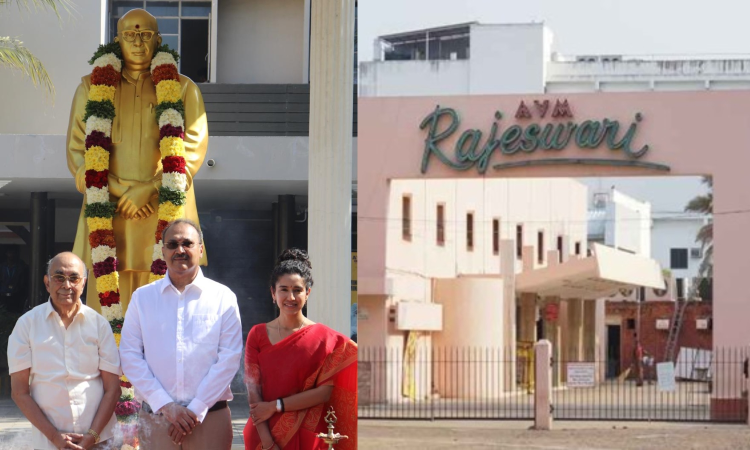End of an era: Chennai remembers the legacy of AVM Rajeswari Theatre
The iconic AVM Globe rotates as the breeze gently hums on Arcot Road. Where once the proud marquee of AVM Rajeswari Theatre caught the evening sun, there is only dust and silence now. For decades, this beloved landmark wasn’t just a cinema—it was memory, emotion, and ritual for generations who grew up in Madras and for those who came to Chennai hoping to make it big in movies. AVM Shanmugam takes us on a nostalgic ride as he shares about the theatre’s journey

AVM Rajeswari Theatre
CHENNAI: For generations of Tamil movie buffs and Tamils alike, AVM Rajeswari Theatre on Arcot Road wasn’t just another cinema hall—it was a portal into the golden age of Tamil cinema. Built in the 1970s by the illustrious AVM family, the theatre stood as a proud emblem of Madras’ deep-rooted film culture, screening everything from black-and-white classics to the first wave of technicolour blockbusters. Its art deco façade, the smell of butter popcorn mingling with sandalwood incense from the nearby temple, and the sight of serpentine queues for Rajinikanth and Kamal Haasan releases—all etched themselves into the city’s collective memory.
"My grandfather, AV Meiyappan, was involved in the theatre business right from the early days. In the 1940s, he moved to Chennai and engaged in film productions. But deep inside, he aspired to be an exhibitor. That was when, in 1978, the Midland Theatre space was up for sale. As the price was quite high, he had to abandon the idea. He later wanted to buy the Pilot theatre in Royapettah, but as there was litigation between the family, he decided against it. However, the desire to run a theatre was reignited in him, leading him to utilise the space within the Vadapalani Press premises and not Kodambakkam,” begins AVM Shanmugam, who managed the theatre alongside his father, AVM Kumaran.
Walking down memory lane, AVM Shanmugam takes DT Next on a nostalgic journey through the early days of the theatre. He used to visit the premises regularly and distinctly recalls his grandfather sitting at the construction site amid the dust. “I was good at geometry. One day, my grandfather asked me to bring my geometry box and instructed me to draw a circle. Then he wanted me to measure triangles and find midpoints. It became like stars. And that was his idea to have lights in the ceiling. Unfortunately, it never materialised. But I was amazed by the extent of self-taught knowledge he possessed,” says an astonished Shanmugam.
Even before the theatre could be inaugurated, AV Meiyappan passed away in 1979 due to pneumonia. “The first film we screened was Sri Valli, in which my grandfather dubbed for Lord Ganesh. It was such an emotional moment and is etched in our memories forever,” he shares.
From the outset, it was a thriving period for AVM Rajeswari Theatre, as it marked numerous milestones in history.
For many, AVM Rajeswari was not just a theatre. It was regarded as something meant for them. “The affordable ticket prices and snacks offered at the theatre were unmatched. When I was a child, I frequently saw families pouring into the theatre, and it felt like a celebration for all. It was a vivid reminder that even the low and middle-income groups deserved to enjoy films in theatres,” notes Jayakumar, a patron of the theatre, with teary eyes as he recalls the past. “I was heartbroken,” he adds upon learning that the theatre is now being demolished, following its closure in 2020.
Now, with its demolition, another piece of old Madras quietly fades into history. What remains are fragments of stories told and retold—of first dates in the balcony, family outings during festivals, and the thrill of watching stars larger than life on that vast silver screen. As the dust settles over the site, so too settles a wistful nostalgia for a time when going to the movies meant more than just buying a ticket — it meant being part of a cultural ritual that defined an era.
“I celebrated all the good moments in my life there. When I received my first salary, I went to AVM Rajeswari to watch a film. After my wedding, my first outing with my wife was to the theatre,” he recalls.
The iconic landmark of Chennai was renowned for having the best sound quality and air conditioning in the town. “In 1983, we released Murattu Kaalai, Sivappu Malli, Pokkiri Raja, Sakalakala Vallavan, Mundhanai Mudichu and Samsaaram Athu Minsaaram, among others. All of these either ran for 100 days or 25 weeks. Our first Hindi film was Mr India, which also made it to the 100-day club,” Shanmugam states.
A major milestone took place in the journey of the theatre in 1995 when Kamal Haasan requested to play Kurudhi Punal in Dolby. “We had technicians coming from Bombay’s RS Electronics. According to the Dolby engineers, the theatre was so perfectly proportioned that the sound reached every nook and corner of the hall. We were the pioneers to adopt Dolby Analogue and also Digital with Karuppu Roja,” says the managing director of AVM Productions Private Limited.
The AVM family had a good rapport with Ranganathan from 20th Century Fox. He requested them to screen Braveheart (1995). However, AVM Kumaran and Shanmugam were quite skeptical about the decision. But the following week, there was an Oscar announcement. And people started flooding the theatre to watch the award-winning film. Then, in 1996, Ajith Kumar’s Kadhal Kottai ran for over a year. Titanic was screened in the theatre for nine months, and with Suriya-starrer Perazhagan in 2004, another historic moment took place. “This film was Qube’s first digital film to be screened in India, and we were the first,” Shanmugam says.
Discussing the flourishing period of theatres, Shanmugam attributes this to the waiving of 30 per cent taxes on Tamil films by the Tamil Nadu Government in 2006. And, the film with Tamil names was allowed to be screened. “It was a major boost to small-budget films, and the trade became healthy. But that didn’t last long. Gradually, people started becoming greedy and charged theatres exorbitant percentages. 60 to 70 per cent of the revenue would be taken away by them in the first week. And that was a setback for exhibitors,” he notes.
To worsen the situation, GST was implemented. On top of it, the local government also ordered them to pay local body tax. All these charges were added on top of the ticket price, which the audience was expected to bear. “My father was clear that we would not run a business that was at a loss. So, after four years of discussion, we decided to shut the theatre in 2020. As films are now accessible at home, the era of theatres is gradually being replaced. Cinema was once an entertainment for the common people in India. But now it is not the same and has become segmented,” he explains.
Providing insights into the reasons behind the long, successful journey of AVM Rajeswari, Shanmugam explains, “My grandfather believed that producers, actors, technicians and even mediators should make money. Everyone should benefit for the trade to flourish. Our selection of films, with the help of our manager Sharma, also paved the way for success. He would say, Namma theatre la nirachu odum sir, then the film would definitely be a hit not just in AVM Rajeswari but across Tamil Nadu. We focus on family-oriented films. If we understand the audience, then we can succeed.”
As the 800-seater building is demolished, a portion of the space is going to be an extension of Kauvery Hospital.
Now, as the theatre’s final curtain falls, Chennai mourns quietly. Another piece of its cinematic soul has been lost to time, but in the minds of those who once queued up beneath its grand façade, AVM Rajeswari will forever play on—reel after reel, memory after memory.



